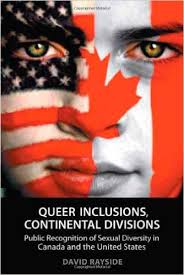 Queer Inclusions, Continental Divisions:
Queer Inclusions, Continental Divisions:
Public Recognition of Sexual Diversity in Canada
and the United States
by David Rayside
University of Toronto Press. 440 pages, $35.
THE 49TH PARALLEL marks a division of great importance for GLBT people. To the north lies Canada’s federal recognition of same-sex marriage (and, importantly, de facto straight and queer couples); to the south, the American Defense of Marriage Act. The latter represents an entrenched state-by-state framework for the distribution of certain rights, while Canada is united by the so-called “living tree” of the Canadian Charter of Rights and Freedoms.
In his new book on this sociopolitical divide, David Rayside posits that nationalistic attempts to differentiate the two countries have sometimes intensified the fight for equality. He argues that “widespread suspicion or skepticism about moral conservatism in the United States intensified during the administration of George W. Bush,” and acted as a spur to Canada’s move toward a recognition of same-sex marriage and other protections. Conversely, American anti-gay activists have used Canada as an object lesson of moral decay in a secularized society.
The strength of religiously motivated right-wing organizations in the U.S. has meant that GLBT people have had to fight that much harder to secure the most basic civil rights, with uneven success on a state-by-state basis. Rayside takes an activist approach and focuses on the vulnerabilities in law and public policy that might provide an opening for successful GLBT rights lobbying. The strength of Queer Inclusions lies in the way it maps the gains and losses in specific areas of sexual diversity recognition. Why, for example, were the litigants in Massachusetts able to secure marriage equality, while other states—even ostensibly “blue” ones—have enacted bans on same-sex marriage? Strategically speaking, Rayside’s preference is for what he calls “incrementalism.” The history of public policy reform reveals that success is achieved through small steps, beginning with decriminalization before moving to a positive assertion of equality.
Rayside shines a spotlight on the elements of each country’s culture that have produced unanticipated openings for queer success. In Canada, for example, the presence of a large Catholic school system in several major cities, which might otherwise be taken as a sign of conservative strength, had the effect of pulling many Catholics out of the public debate and shrinking the opposition to a secular, GLBT-inclusive curriculum in the public schools. In the U.S., by contrast, gay-sensitive policies more often arose from an increase in the incidence of high-profile school violence and public awareness of the impact of homophobic bullying.
Queer Inclusions places the American and Canadian experience in context by ending with a global analysis of public policy trends. The book as a whole can be read as a primer on queer activism, with insights on how better to know the enemy and how to argue the case for equality. It can also be read as a general history of the struggle for equality in the two countries—the small victories and unsung heroes along with the major breakthroughs—in recent years.
______________________________________________________________
Patty Comeau is a freelance journalist based in Vancouver, British Columbia.






